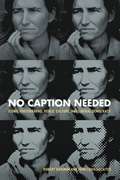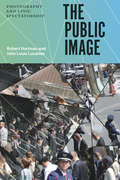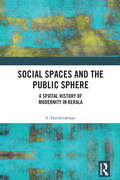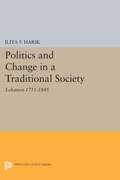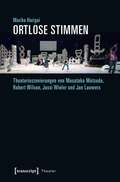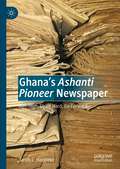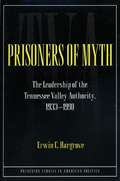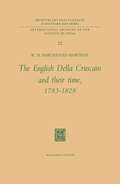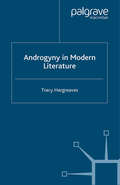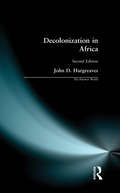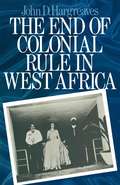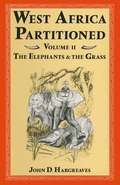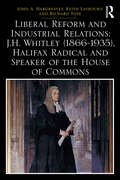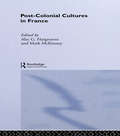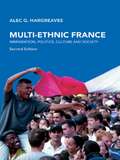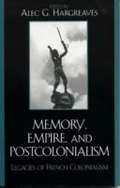- Table View
- List View
No Caption Needed: Iconic Photographs, Public Culture, and Liberal Democracy
by Robert Hariman John Louis LucaitesIn No Caption Needed, Robert Hariman and John Louis Lucaites provide the definitive study of the iconic photograph as a dynamic form of public art. Their critical analyses of nine individual icons explore the photographs themselves and their subsequent circulation through an astonishing array of media, including stamps, posters, billboards, editorial cartoons, TV shows, Web pages, tattoos, and more. Iconic images are revealed as models of visual eloquence, signposts for collective memory, means of persuasion across the political spectrum, and a crucial resource for critical reflection. Arguing against the conventional belief that visual images short-circuit rational deliberation and radical critique, Hariman and Lucaites make a bold case for the value of visual imagery in a liberal-democratic society. No Caption Needed is a compelling demonstration of photojournalism’s vital contribution to public life.
The Public Image: Photography and Civic Spectatorship
by Robert Hariman John Louis LucaitesEven as the media environment has changed dramatically in recent years, one thing at least remains true: photographs are everywhere. From professional news photos to smartphone selfies, images have become part of the fabric of modern life. And that may be the problem. Even as photography bears witness, it provokes anxieties about fraudulent representation; even as it evokes compassion, it prompts anxieties about excessive exposure. Parents and pundits alike worry about the unprecedented media saturation that transforms society into an image world. And yet a great news photo can still stop us in our tracks, and the ever-expanding photographic archive documents an era of continuous change. By confronting these conflicted reactions to photography, Robert Hariman and John Louis Lucaites make the case for a fundamental shift in understanding photography and public culture. In place of suspicions about the medium’s capacity for distraction, deception, and manipulation, they suggest how it can provide resources for democratic communication and thoughtful reflection about contemporary social problems. The key to living well in the image world is to unlock photography from viewing habits that inhibit robust civic spectatorship. Through insightful interpretations of dozens of news images, The Public Image reveals how the artistry of the still image can inform, challenge, and guide reflection regarding endemic violence, environmental degradation, income inequity, and other chronic problems that will define the twenty-first century. By shifting from conventional suspicions to a renewed encounter with the image, we are challenged to see more deeply on behalf of a richer life for all, and to acknowledge our obligations as spectators who are, crucially, also citizens.
The Public Image: Photography and Civic Spectatorship
by Robert Hariman John Louis LucaitesEven as the media environment has changed dramatically in recent years, one thing at least remains true: photographs are everywhere. From professional news photos to smartphone selfies, images have become part of the fabric of modern life. And that may be the problem. Even as photography bears witness, it provokes anxieties about fraudulent representation; even as it evokes compassion, it prompts anxieties about excessive exposure. Parents and pundits alike worry about the unprecedented media saturation that transforms society into an image world. And yet a great news photo can still stop us in our tracks, and the ever-expanding photographic archive documents an era of continuous change. By confronting these conflicted reactions to photography, Robert Hariman and John Louis Lucaites make the case for a fundamental shift in understanding photography and public culture. In place of suspicions about the medium’s capacity for distraction, deception, and manipulation, they suggest how it can provide resources for democratic communication and thoughtful reflection about contemporary social problems. The key to living well in the image world is to unlock photography from viewing habits that inhibit robust civic spectatorship. Through insightful interpretations of dozens of news images, The Public Image reveals how the artistry of the still image can inform, challenge, and guide reflection regarding endemic violence, environmental degradation, income inequity, and other chronic problems that will define the twenty-first century. By shifting from conventional suspicions to a renewed encounter with the image, we are challenged to see more deeply on behalf of a richer life for all, and to acknowledge our obligations as spectators who are, crucially, also citizens.
The Public Image: Photography and Civic Spectatorship
by Robert Hariman John Louis LucaitesEven as the media environment has changed dramatically in recent years, one thing at least remains true: photographs are everywhere. From professional news photos to smartphone selfies, images have become part of the fabric of modern life. And that may be the problem. Even as photography bears witness, it provokes anxieties about fraudulent representation; even as it evokes compassion, it prompts anxieties about excessive exposure. Parents and pundits alike worry about the unprecedented media saturation that transforms society into an image world. And yet a great news photo can still stop us in our tracks, and the ever-expanding photographic archive documents an era of continuous change. By confronting these conflicted reactions to photography, Robert Hariman and John Louis Lucaites make the case for a fundamental shift in understanding photography and public culture. In place of suspicions about the medium’s capacity for distraction, deception, and manipulation, they suggest how it can provide resources for democratic communication and thoughtful reflection about contemporary social problems. The key to living well in the image world is to unlock photography from viewing habits that inhibit robust civic spectatorship. Through insightful interpretations of dozens of news images, The Public Image reveals how the artistry of the still image can inform, challenge, and guide reflection regarding endemic violence, environmental degradation, income inequity, and other chronic problems that will define the twenty-first century. By shifting from conventional suspicions to a renewed encounter with the image, we are challenged to see more deeply on behalf of a richer life for all, and to acknowledge our obligations as spectators who are, crucially, also citizens.
The Public Image: Photography and Civic Spectatorship
by Robert Hariman John Louis LucaitesEven as the media environment has changed dramatically in recent years, one thing at least remains true: photographs are everywhere. From professional news photos to smartphone selfies, images have become part of the fabric of modern life. And that may be the problem. Even as photography bears witness, it provokes anxieties about fraudulent representation; even as it evokes compassion, it prompts anxieties about excessive exposure. Parents and pundits alike worry about the unprecedented media saturation that transforms society into an image world. And yet a great news photo can still stop us in our tracks, and the ever-expanding photographic archive documents an era of continuous change. By confronting these conflicted reactions to photography, Robert Hariman and John Louis Lucaites make the case for a fundamental shift in understanding photography and public culture. In place of suspicions about the medium’s capacity for distraction, deception, and manipulation, they suggest how it can provide resources for democratic communication and thoughtful reflection about contemporary social problems. The key to living well in the image world is to unlock photography from viewing habits that inhibit robust civic spectatorship. Through insightful interpretations of dozens of news images, The Public Image reveals how the artistry of the still image can inform, challenge, and guide reflection regarding endemic violence, environmental degradation, income inequity, and other chronic problems that will define the twenty-first century. By shifting from conventional suspicions to a renewed encounter with the image, we are challenged to see more deeply on behalf of a richer life for all, and to acknowledge our obligations as spectators who are, crucially, also citizens.
Social Spaces and the Public Sphere: A Spatial-history of Modernity in Kerala
by S. HarikrishnanWhat can social spaces tell us about social relations in society? How do everyday social spaces like teashops, reading rooms, and libraries reify—or subvert—dominant social structures like caste and gender? These are the questions that this book explores through a study of modern Kerala. Using archival material, discourse analysis, participant observation, and personal interviews, this book traces the transformation of public spaces through the nineteenth and twentieth centuries. The volume focuses on how "modernity" has also been a struggle for access to public spaces, and non-institutional spaces like teashops, markets, public roads, temple grounds, reading rooms, and libraries have all been crucial to how political culture was shaped, and how dominant hegemonies—caste, class, or capital—have been challenged. It suggests that the secular public sphere that emerged in the last century in Kerala was a result of the constant negotiations between conflicting ideas which were put to test in these social spaces. At a time when digital spaces are fast replacing physical ones, this book is a timely reminder of the struggles that led to the emergence of secular public spaces in Kerala. It contributes to similar studies on public space that have emerged from other parts of the world over the last decades. A major contribution to understanding modern India, this book will be of interest to scholars and researchers of social history, political science, political sociology, gender studies, linguistics, and South Asian studies.
Social Spaces and the Public Sphere: A Spatial-history of Modernity in Kerala
by S. HarikrishnanWhat can social spaces tell us about social relations in society? How do everyday social spaces like teashops, reading rooms, and libraries reify—or subvert—dominant social structures like caste and gender? These are the questions that this book explores through a study of modern Kerala. Using archival material, discourse analysis, participant observation, and personal interviews, this book traces the transformation of public spaces through the nineteenth and twentieth centuries. The volume focuses on how "modernity" has also been a struggle for access to public spaces, and non-institutional spaces like teashops, markets, public roads, temple grounds, reading rooms, and libraries have all been crucial to how political culture was shaped, and how dominant hegemonies—caste, class, or capital—have been challenged. It suggests that the secular public sphere that emerged in the last century in Kerala was a result of the constant negotiations between conflicting ideas which were put to test in these social spaces. At a time when digital spaces are fast replacing physical ones, this book is a timely reminder of the struggles that led to the emergence of secular public spaces in Kerala. It contributes to similar studies on public space that have emerged from other parts of the world over the last decades. A major contribution to understanding modern India, this book will be of interest to scholars and researchers of social history, political science, political sociology, gender studies, linguistics, and South Asian studies.
Politics and Change in a Traditional Society: Lebanon 1711-1845
by Iliya F. HarikThe author considers the transformation of Lebanese feudalism into a communal system with burgeoning national consciousness. He places particular emphasis on the conflict between institutions and on the impact of nonpolitical organizations on the political system.Originally published in 1968.The Princeton Legacy Library uses the latest print-on-demand technology to again make available previously out-of-print books from the distinguished backlist of Princeton University Press. These editions preserve the original texts of these important books while presenting them in durable paperback and hardcover editions. The goal of the Princeton Legacy Library is to vastly increase access to the rich scholarly heritage found in the thousands of books published by Princeton University Press since its founding in 1905.
Ortlose Stimmen: Theaterinszenierungen von Masataka Matsuda, Robert Wilson, Jossi Wieler und Jan Lauwers (Theater #105)
by Mariko HarigaiStimmen schweben immer in einem Dazwischen. Sie übertragen nicht nur Sprache, sondern lassen als Spur auch vernehmen, woher sie ertönen, und rufen die Hörenden dorthin auf. Zugleich werden diese Orte jedoch aufgelöst. Stimmen lassen uns dabei ihre eigene Ortlosigkeit vernehmen. Anhand von Analysen von Theaterinszenierungen von Masataka Matsuda, Jossi Wieler, Robert Wilson und Jan Lauwers zeigt Mariko Harigai: Das Theater macht die Entstehungs- und Auflösungsprozesse solcher Orte durch Stimmen spürbar.
Ghana’s Ashanti Pioneer Newspaper: Aim High, Strive Hard, Go Forward
by Jarvis L. HargroveThis book is a history of a prominent Ghanaian newspaper, the Ashanti Pioneer, as well as well-known figurers in the country itself. It utilizes the stories published in the newspaper to recount the history of the press, including its key individuals and groups, and to provide a unique perspective on the most important events in the Gold Coast during the mid-twentieth century, just prior to and after independence. This work will show that the Ashanti Pioneer influenced public opinion on several subjects. From its opening in 1939, the newspaper contributed greatly to the spread of newsworthy information throughout Ghana, formerly known as the Gold Coast, from Kumasi to the coastline and to its Northern borders. Readers interested in African History, independence movements and newspaper history will find this work insightful.
Prisoners of Myth: The Leadership of the Tennessee Valley Authority, 1933-1990
by Erwin C. HargrovePrisoners of Myth is the first comprehensive history of the Tennessee Valley Authority from its creation to the present day. It is also a telling case study of organizational evolution and decline. Building on Philip Selznick's classic work TVA and the Grass Roots (1949), a seminal text in the theoretical study of bureaucracy, Erwin Hargrove analyzes the organizational culture of the TVA by looking at the actions of its leaders over six decades--from the heroic years of the New Deal and World War II through the postwar period of consolidation and growth to the time of troubles from 1970 onward, when the TVA ran afoul of environmental legislation, built a massive nuclear power program that it could not control, and sought new missions for which there were no constituencies.The founding myth of multipurpose regional development was inappropriately pursued in the 1970s and '80s by leaders who became "prisoners of myth" in their attempt to keep the TVA heroic. A decentralized organization, which had worked well at the grass roots, was difficult to redirect as the nuclear genii spun out of control. TVA autonomy from Washington, once a virtue, obscured political accountability. This study develops an important new theory about institutional performance in the face of historical change.
Prisoners of Myth: The Leadership of the Tennessee Valley Authority, 1933-1990 (Princeton Studies in American Politics: Historical, International, and Comparative Perspectives #39)
by Erwin C. HargrovePrisoners of Myth is the first comprehensive history of the Tennessee Valley Authority from its creation to the present day. It is also a telling case study of organizational evolution and decline. Building on Philip Selznick's classic work TVA and the Grass Roots (1949), a seminal text in the theoretical study of bureaucracy, Erwin Hargrove analyzes the organizational culture of the TVA by looking at the actions of its leaders over six decades--from the heroic years of the New Deal and World War II through the postwar period of consolidation and growth to the time of troubles from 1970 onward, when the TVA ran afoul of environmental legislation, built a massive nuclear power program that it could not control, and sought new missions for which there were no constituencies.The founding myth of multipurpose regional development was inappropriately pursued in the 1970s and '80s by leaders who became "prisoners of myth" in their attempt to keep the TVA heroic. A decentralized organization, which had worked well at the grass roots, was difficult to redirect as the nuclear genii spun out of control. TVA autonomy from Washington, once a virtue, obscured political accountability. This study develops an important new theory about institutional performance in the face of historical change.
The English Della Cruscans and Their Time, 1783–1828 (International Archives of the History of Ideas Archives internationales d'histoire des idées #22)
by W.N. Hargreaves-MawdsleyThe English Della Cruscan School, although its nucleus was formed in 1785 by the publication of The Florence Miscellany, existed neither in the consciousness of the group which formed it nor in that of the pu blic until it was so dubbed as a term of reproach by William Gifford in his bitter satire The Baviad (1791). As has already been mentioned Merry, the leader of the group, claimed to be a member of the Real Accademia Fiorentina which had swallowed up the Crusca and the two other Floren tine Academies in 1783; but it was not until the summer of 1787, when during his lingering voyage of return to England he began to send his contributions signed "Della Crusca" to the World, that the name became publicly known or even employed by his friends. Merry uses it of himself in a letter to Mrs. Piozzi after his arrival in England, on 27th February, 1788. 1 His public avowal of his romantic yearning after the suppressed Accademia della Crusca appears on the title-page of his Paulina (1787); for whereas on the title-page of Robert Manners (1785) he for the first time calls himself "A Member of the Royal Academy of Florence," the author of Paulina, "Robert Merry, Esq.
Androgyny in Modern Literature
by T. HargreavesAndrogyny in Modern Literature engages with the ways in which the trope of androgyny has shifted during the late nineteenth and twentieth-centuries. Alchemical, platonic, sexological, psychological and decadent representations of androgyny have provided writers with an icon which has been appropriated in diverse ways. This fascinating new study traces different revisions of the psycho-sexual, embodied, cultural and feminist fantasies and repudiations of this unstable but enduring trope across a broad range of writers from the fin de siècle to the present.
Decolonization in Africa (The Postwar World)
by John D. HargreavesJohn Hargreaves examines how the British, French, Belgian, Spanish and Portuguese colonies in tropical Africa became independent in the postwar years, and in doing so transformed the international landscape. African demands for independence and colonial plans for reform - central to the story - are seen here in the wider context of changing international relationships.
Decolonization in Africa (The Postwar World)
by John D. HargreavesJohn Hargreaves examines how the British, French, Belgian, Spanish and Portuguese colonies in tropical Africa became independent in the postwar years, and in doing so transformed the international landscape. African demands for independence and colonial plans for reform - central to the story - are seen here in the wider context of changing international relationships.
Liberal Reform and Industrial Relations: J. H. Whitley (1866-1935), Halifax Radical And Speaker Of The House Of Commons (Routledge Studies in Modern British History)
by John A. Hargreaves Keith Laybourn Richard ToyeJ.H. Whitley came from an established business family in Halifax, where he engaged in youth work and municipal politics before becoming MP for Halifax from 1900 to 1928. He was a Liberal Radical who worked with Labour, gave his name to the industrial councils of the First World War, was Speaker of the House of Commons 1921-28 presiding over the debates at the time of the General Strike of 1926. In 1929-31 he toured India as chairman of the Royal Commission on Indian Labour and was chairman of the BBC between 1930 and 1935. He was thus a vitally important political figure who was active at the rise of Labour and the decline of Liberalism, involved in the Liberal reforms of the Edwardian age, and deeply concerned about industrial relations in early twentieth century Britain and beyond. This volume brings together leading academics and provides new information and analysis on the life, work and times of J.H. Whitley, offering a study of his career in British politics and society, focusing particularly on the last decade of the nineteenth century and the first three decades of the twentieth century.
Liberal Reform and Industrial Relations: J.H. Whitley (Routledge Studies in Modern British History)
by John A. Hargreaves Keith Laybourn Richard ToyeJ.H. Whitley came from an established business family in Halifax, where he engaged in youth work and municipal politics before becoming MP for Halifax from 1900 to 1928. He was a Liberal Radical who worked with Labour, gave his name to the industrial councils of the First World War, was Speaker of the House of Commons 1921-28 presiding over the debates at the time of the General Strike of 1926. In 1929-31 he toured India as chairman of the Royal Commission on Indian Labour and was chairman of the BBC between 1930 and 1935. He was thus a vitally important political figure who was active at the rise of Labour and the decline of Liberalism, involved in the Liberal reforms of the Edwardian age, and deeply concerned about industrial relations in early twentieth century Britain and beyond. This volume brings together leading academics and provides new information and analysis on the life, work and times of J.H. Whitley, offering a study of his career in British politics and society, focusing particularly on the last decade of the nineteenth century and the first three decades of the twentieth century.
Post-Colonial Cultures in France
by Alec Hargreaves Mark McKinneyEthnic minorities, principally from Africa, Asia, the Caribbean and the surviving remnants of France's overseas empire, are increasingly visible in contemporary France. Post-Colonial Cultures in France edited by Alec Hargreaves and Mark McKinney is the first wide-ranging survey in English of the vibrant cultural practices now being forged by France's post-colonial minorities. The contributions in Post-Colonial Cultures in France cover both the ethnic diversity of minority groups and a variety of cultural forms ranging from literature and music to film and television. Using a diversity of critical and theoretical approaches from the disciplines of cultural studies, literary studies, migration studies, anthropology and history, Post-Colonial Cultures in France explores the globalization of cultures and international migration.
Post-Colonial Cultures in France
by Alec Hargreaves Mark McKinneyEthnic minorities, principally from Africa, Asia, the Caribbean and the surviving remnants of France's overseas empire, are increasingly visible in contemporary France. Post-Colonial Cultures in France edited by Alec Hargreaves and Mark McKinney is the first wide-ranging survey in English of the vibrant cultural practices now being forged by France's post-colonial minorities. The contributions in Post-Colonial Cultures in France cover both the ethnic diversity of minority groups and a variety of cultural forms ranging from literature and music to film and television. Using a diversity of critical and theoretical approaches from the disciplines of cultural studies, literary studies, migration studies, anthropology and history, Post-Colonial Cultures in France explores the globalization of cultures and international migration.
Multi-Ethnic France: Immigration, Politics, Culture and Society
by Alec G. HargreavesThis second edition of Multi-Ethnic France spans politics and economics, social structures and cultural practices and has been updated to cover events which have occurred on the national and international stage since the first edition was published. These include: recent developments in the Banlieues, including the riots of 2005 the growing visibility of sub-Saharan Africans in France's evolving ethnic mix the reverberations in France of international developments such as 9/11, the second Intifada and the Iraq Wars the renewed controversy over the wearing of the Islamic headscarf the development of anti-discrimination policy and the debate over 'positive discrimination'. Immigration is one of the most significant and persistent issues in contemporary France. It has become central to political debate with the rise, on one side, of Jean-Marie Le Pen's extreme right-wing party and, on the other, of Islamist terrorism. In Multi-Ethnic France, Alec G. Hargreaves unmasks the prejudices and misconceptions faced by minorities of Muslim heritage and lays bare the social and political neglect behind the riots of 2005. This second edition is fully updated, and includes a glossary and chronology, as well as a revised bibliography.
Multi-Ethnic France: Immigration, Politics, Culture and Society
by Alec G. HargreavesThis second edition of Multi-Ethnic France spans politics and economics, social structures and cultural practices and has been updated to cover events which have occurred on the national and international stage since the first edition was published. These include: recent developments in the Banlieues, including the riots of 2005 the growing visibility of sub-Saharan Africans in France's evolving ethnic mix the reverberations in France of international developments such as 9/11, the second Intifada and the Iraq Wars the renewed controversy over the wearing of the Islamic headscarf the development of anti-discrimination policy and the debate over 'positive discrimination'. Immigration is one of the most significant and persistent issues in contemporary France. It has become central to political debate with the rise, on one side, of Jean-Marie Le Pen's extreme right-wing party and, on the other, of Islamist terrorism. In Multi-Ethnic France, Alec G. Hargreaves unmasks the prejudices and misconceptions faced by minorities of Muslim heritage and lays bare the social and political neglect behind the riots of 2005. This second edition is fully updated, and includes a glossary and chronology, as well as a revised bibliography.
Memory, Empire, And Postcolonialism: Legacies Of French Colonialism (PDF) (After The Empire Ser.)
by Alec Hargreaves Joshua Cole Sylvie Durmelat Janice Gross Dayna OscherwitzLong repressed following the collapse of empire, memories of the French colonial experience have recently gained unprecedented visibility. In popular culture, scholarly research, personal memoirs, public commemorations, and new ethnicities associated with the settlement of postcolonial immigrant minorities, the legacy of colonialism is now more apparent in France than at any time in the past. How is this upsurge of interest in the colonial past to be explained? Does the commemoration of empire necessarily imply glorification or condemnation? To what extent have previously marginalized voices succeeded in making themselves heard in new narratives of empire? While veils of secrecy have been lifted, what taboos still remain and why? These are among the questions addressed by an international team of leading researchers in this interdisciplinary volume, which will interest scholars in a wide range of disciplines including French studies, history, literature, cultural studies, and anthropology.
